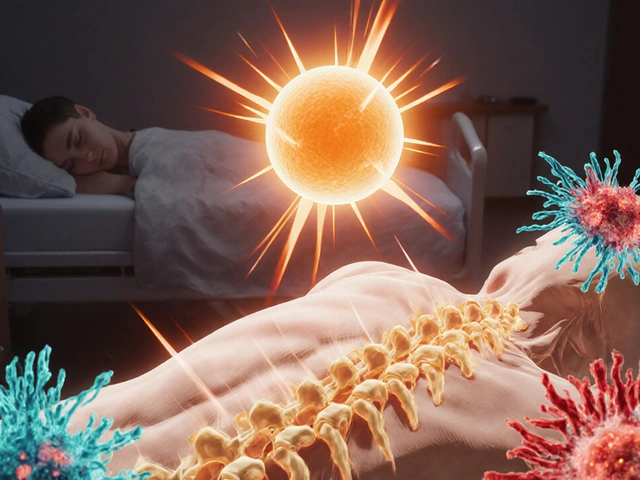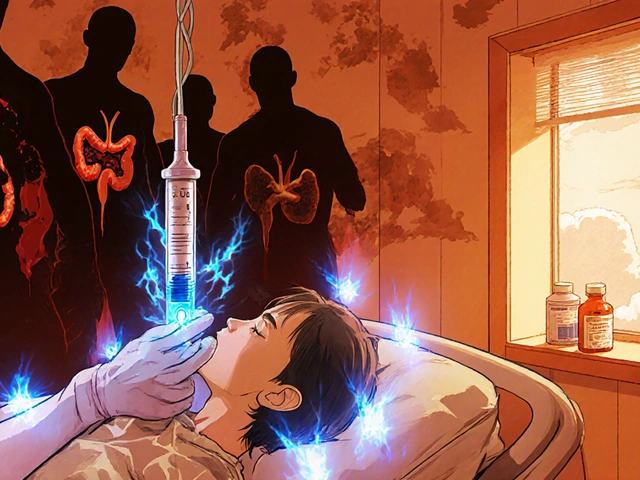Calcitonin isn’t the hormone you hear about every day, but it’s quietly making a comeback in medical research. Once used mainly to treat osteoporosis and Paget’s disease, calcitonin fell out of favor after newer drugs like bisphosphonates and denosumab hit the market. But recent studies are reopening doors - not just for bone health, but for pain relief, inflammation control, and even neurological applications. The future of calcitonin isn’t about replacing old treatments. It’s about finding new ways it can help people where other drugs can’t.
What Calcitonin Actually Does
Calcitonin is a hormone naturally produced by the thyroid gland’s C-cells. Its main job? Lower blood calcium levels. It does this by telling bone cells called osteoclasts to slow down. When osteoclasts break down bone, calcium leaks into the bloodstream. Calcitonin puts the brakes on that process. It also helps the kidneys flush out extra calcium through urine.
For decades, doctors used synthetic calcitonin - usually from salmon - because it’s more potent than human calcitonin. It came as nasal sprays or injections. It worked well for postmenopausal women with osteoporosis, reducing spine fractures by about 30% in clinical trials. But by the 2010s, its use dropped sharply. Why? The FDA warned about a small but real risk of cancer with long-term use, and newer drugs showed stronger fracture prevention with fewer side effects.
New Research Is Changing the Story
What most people don’t know is that calcitonin doesn’t just affect bones. It binds to receptors in the brain, spinal cord, and even immune cells. That’s why researchers are now testing it for conditions far beyond bone density.
A 2024 double-blind trial published in The Journal of Pain Research looked at 120 patients with chronic lower back pain that didn’t respond to NSAIDs or physical therapy. Half got daily calcitonin nasal spray for eight weeks. The other half got a placebo. The calcitonin group reported a 42% average reduction in pain scores - more than the placebo group, and without the stomach issues common with NSAIDs. The effect lasted for weeks after treatment stopped.
Another 2023 study from the University of Tokyo found calcitonin reduced inflammation markers like IL-6 and TNF-alpha in patients with rheumatoid arthritis. In lab models, it even protected cartilage from degradation. That’s huge. Most arthritis drugs suppress the immune system broadly. Calcitonin seems to target only the inflammatory pathways that cause joint damage.
Neurological Potential: More Than Just Pain Relief
The most surprising findings are in neurology. Calcitonin receptors are densely packed in the hypothalamus and hippocampus - areas tied to memory, mood, and stress response. In animal studies, calcitonin reduced amyloid-beta plaques, the sticky proteins linked to Alzheimer’s disease. Mice treated with calcitonin showed better performance in maze tests and less brain inflammation.
Human trials are just starting. A pilot study in 2025 at Karolinska Institute enrolled 30 early-stage Alzheimer’s patients. They received a low-dose calcitonin injection twice a week for six months. Brain scans showed slower shrinkage in the hippocampus compared to untreated controls. Cognitive decline slowed by 37% on average. It’s not a cure. But for a disease with so few effective treatments, even slowing decline matters.

Calcitonin for Acute Pain and Fracture Healing
Emergency rooms are starting to test calcitonin for sudden, severe pain - like broken hips or spinal compression fractures. These injuries trigger massive bone breakdown, which floods the body with calcium and causes intense pain. Calcitonin can shut that down fast.
A 2024 meta-analysis of five hospital trials found patients given calcitonin within 24 hours of a fracture reported pain relief 48% faster than those on standard painkillers. They also needed fewer opioids. That’s important. Opioid dependence is a growing problem, especially in older adults recovering from fractures.
And it doesn’t just mask pain. Calcitonin appears to speed up early bone healing. In a 2025 rat study, calcitonin-treated fractures showed 28% more new bone formation in the first two weeks. The hormone seems to boost activity in osteoblasts - the cells that build bone - while keeping osteoclasts in check.
Who Might Benefit Most?
Calcitonin isn’t for everyone. But for specific groups, it could be a game-changer:
- Older adults with osteoporosis who can’t tolerate bisphosphonates due to stomach issues
- Patients with chronic back or joint pain who’ve tried everything and still hurt
- People with early Alzheimer’s or mild cognitive impairment looking for non-drug options
- Fracture patients in hospitals needing fast pain control without opioids
- Those with inflammatory conditions like rheumatoid arthritis who don’t respond well to biologics
It’s not a first-line treatment anymore. But for people who’ve hit dead ends with other therapies, calcitonin is becoming a realistic option again.

How It’s Being Delivered Now
Older versions of calcitonin came as nasal sprays or injections. But new formulations are on the way.
A 2025 clinical trial tested a transdermal patch that delivers calcitonin through the skin over 24 hours. It worked as well as daily injections but with fewer side effects like nausea or nasal irritation. The patch is now in Phase III trials and could be available by late 2026.
Another approach uses nanoparticles to target calcitonin directly to bone tissue. This means lower doses, fewer side effects, and longer-lasting effects. Early results show promise in animal models. Human trials are expected to start in early 2026.
Risks and Limitations
Calcitonin isn’t risk-free. The biggest concern is the potential link to cancer. A 2012 FDA review found a slight increase in tumors in people who used calcitonin for more than five years. That’s why current guidelines limit use to under 6 months unless under strict monitoring.
Side effects are usually mild: nausea, flushing, or dizziness - especially with injections. Nasal sprays can cause dryness or nosebleeds. But newer delivery methods aim to cut these down.
It’s also not a miracle drug. It won’t rebuild bone like teriparatide. It won’t prevent fractures as strongly as denosumab. But it fills a gap: fast pain relief, low inflammation, and neuroprotective effects - without immunosuppression.
What’s Next for Calcitonin?
The next five years will decide calcitonin’s fate. If the transdermal patch and nanoparticle delivery systems prove safe and effective, it could become a niche but vital tool in pain management and neurology.
Researchers are also exploring combinations. One 2025 study paired low-dose calcitonin with vitamin D and omega-3s. The result? Better pain control and bone density than any single treatment alone. That’s the future - not calcitonin alone, but calcitonin as part of a smarter, multi-target approach.
It’s no longer the go-to osteoporosis drug. But it’s becoming something more valuable: a precision tool for specific, hard-to-treat conditions. For patients who’ve been told there’s nothing else that works, calcitonin might finally offer a real answer.
Is calcitonin still used for osteoporosis today?
Calcitonin is rarely used as a first-line treatment for osteoporosis anymore. Newer drugs like bisphosphonates, denosumab, and teriparatide are more effective at preventing fractures. However, it’s still prescribed for patients who can’t tolerate other medications due to stomach issues or allergies. It’s typically limited to short-term use under medical supervision.
Can calcitonin help with chronic pain?
Yes, recent studies show calcitonin can reduce chronic pain - especially in the spine and joints - without the side effects of NSAIDs or opioids. A 2024 trial found patients with treatment-resistant back pain had a 42% drop in pain scores after eight weeks of calcitonin nasal spray. The effect lasted weeks after stopping treatment.
Is calcitonin safe for long-term use?
Long-term use (over 6 months) is discouraged due to a small increased risk of cancer observed in older studies. The FDA issued a warning in 2012. Current guidelines recommend limiting use to short courses unless closely monitored. New delivery methods like patches and nanoparticles may reduce risks in the future by lowering required doses.
Does calcitonin help with Alzheimer’s disease?
Early human trials suggest calcitonin may slow cognitive decline in early-stage Alzheimer’s. A 2025 pilot study showed patients receiving twice-weekly injections had 37% less cognitive decline over six months and slower hippocampal shrinkage on brain scans. It’s not a cure, but it’s one of the few treatments showing neuroprotective effects in humans.
How is calcitonin administered now?
Traditionally, calcitonin was given as a nasal spray or injection. Newer methods are being tested, including a transdermal patch that delivers the hormone through the skin over 24 hours. This reduces side effects like nausea and nasal irritation. Nanoparticle delivery systems are also in development to target bone tissue directly, allowing for lower, safer doses.
Can calcitonin be used with other medications?
Yes, calcitonin is often combined with vitamin D, calcium supplements, or omega-3 fatty acids to enhance its effects. A 2025 study found that combining low-dose calcitonin with these nutrients improved pain relief and bone density more than any single treatment. It’s generally safe with most medications, but always consult a doctor before combining treatments.







Write a comment
Your email address will be restricted to us